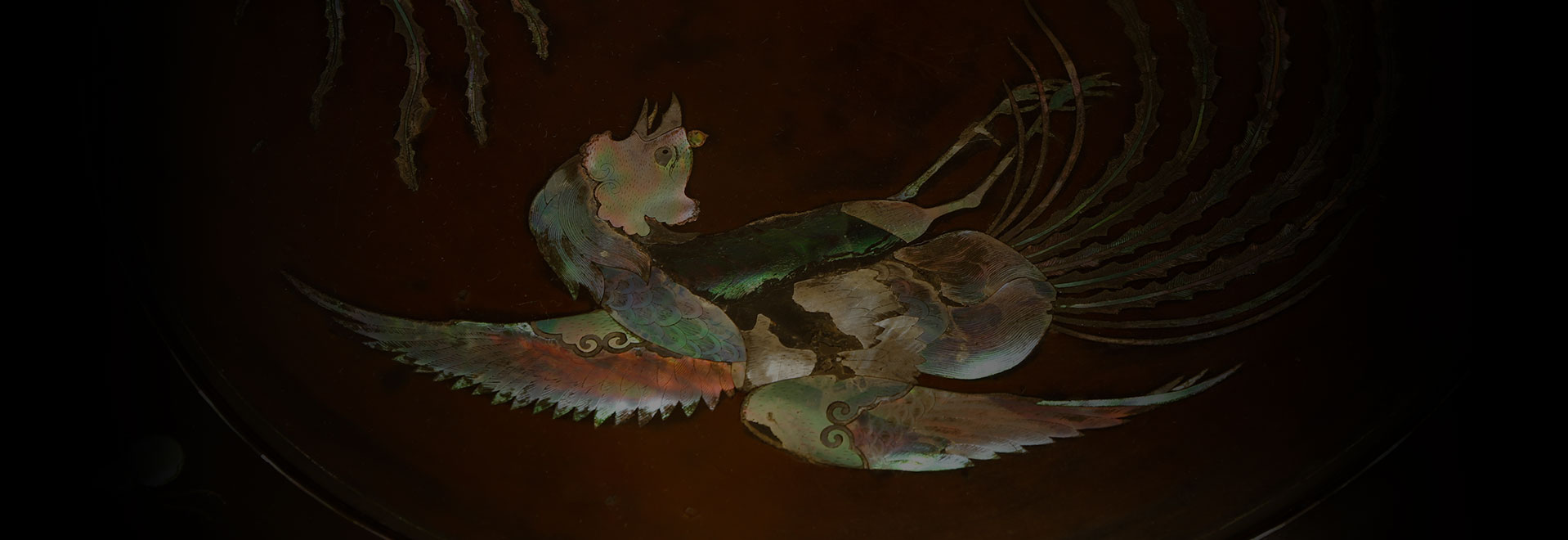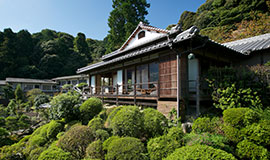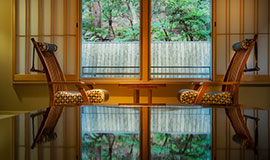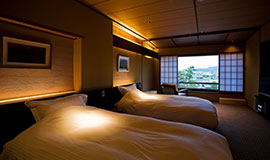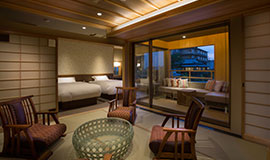Art

- HOME
- Explore Sanuki
- Art
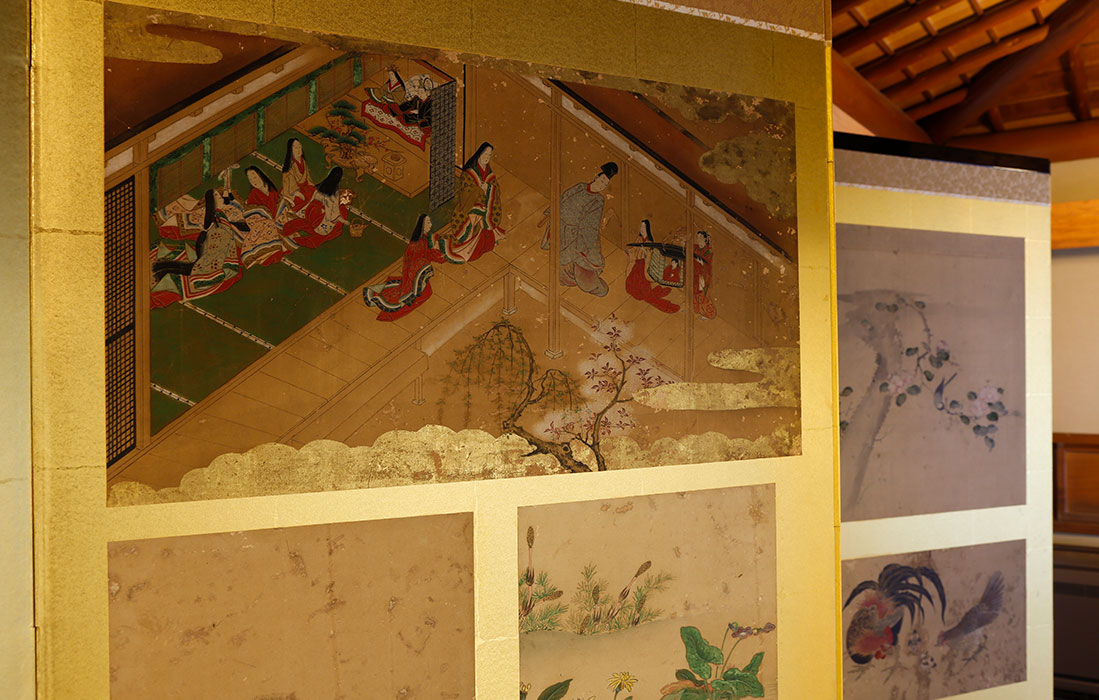
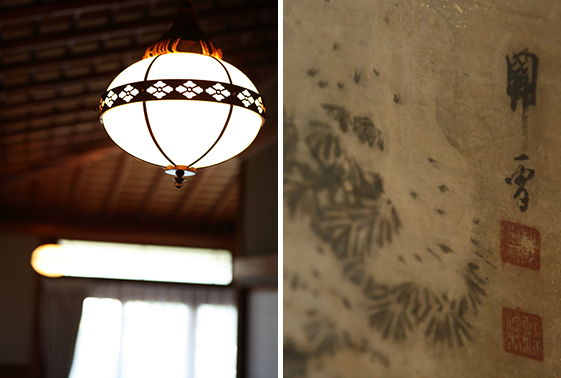
Sanuki Art Journey
Choseiden, one of Kotohira Kadan's sukiya-style cottages, could be called a miniature museum of classic Japanese art. In every corner and on every surface, there is something beautiful to behold. Traditional paintings decorate gold-leaf folding screens, and the fusuma sliding doors are painted with art dating back to the mid-1800s. Choseiden also boasts interior splendor with early 20th-century light fixtures and wave glass windows which reflect the beauty of the garden outside.

Art Comes Alive
in Kagawa
01. Art & A PrayerAt Konpira-san, you can both pray and view truly rare art all at once. The Drawing Room, along the approach to the main shrine, houses a fusuma painting by Maruyama Okyo of two tigers which dates from the late 1700s. Konpira-san's Treasure House and the Takahashi Yuichi (the artist who pioneered Western-style painting in the late 19th century) Museum are also must-see places for art lovers.
02. World Class Art MuseumsKagawa's reputation as an art hub has grown in recent years and the whole prefecture boasts museums and art installations even in the remotest of areas. Many artists have called Kagawa home, and the legacies they have left here, like the Inokuma Genichiro Museum of Contemporary Art, the Higashiyama Kaii Setouchi Museum, and many others, offer deep insight into the world of Japanese modern art.
03. Travel the Islands, Travel through ArtThe Setouchi Triennale, a prefecture-wide art festival held every three years, has made Kagawa part of the international art scene. Along with the popularity of the Seto Inland Sea as a tourist destination, both nature and art come together to make the area a premiere destination in Japan. The Triennale's art is immersive, and the installations remain in place even after the festival ends so they can be appreciated again and again. Most exhibition islands can be reached by ferry from Takamatsu, so explore and expand your appreciation of comtemporary art.
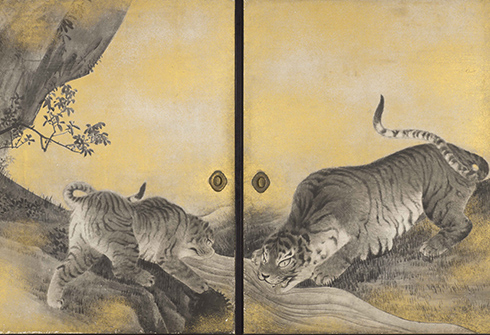 01
01
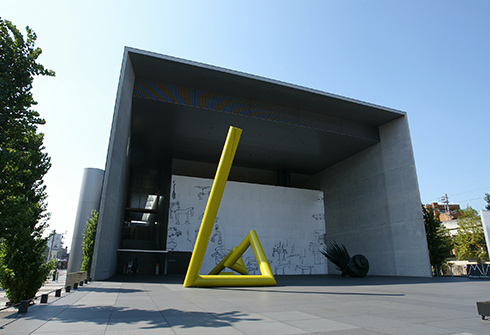 02
02
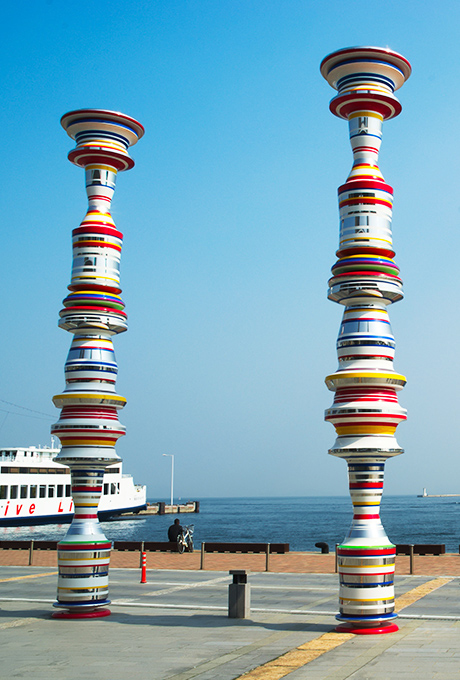 03
03
Explore Sanuki/Art

Omote Shoin (Drawing Room, Kotohira-gu Shrine)
Kotohira-cho/35 min. walk
Konpira-san's Omote Shoin, or Drawing Room, is thought to have been built between 1658-1660. It is known for its spectacular fusuma paintings done by Maruyama Okyo. He began them in his later years, and they were completed just before the turn of the 18th century. The paintings themselves are said to have been done in Kyoto, and were commissioned with financial help from the Mitsui family.

Takahashi Yuichi Museum (Kotohira-gu Shrine)
Kotohira-cho/30 min. walk
Takahashi Yuichi is known as the Father of Modern Western-style Japanese painting, and his works "Salmon" and "Courtesan" (both Important Cultural Properties in the Tokyo University of the Arts Museum collection) are among the first Western-style art created by Japanese artists. Kotohira-gu's on-site museum is home to 27 of his oil paintings.

Marugame Genichiro-Inokuma Museum of Contemporary Art
Marugame City/25 min. by car
This rare station-front museum was created with the cooperation of Inokuma Genichiro, who is considered the pride of Marugame City. Spanning over 70 years of Inokuma's career, visitors can see not only his representative works but also explore the local art culture of the area.

Marugame Art Museum (Nakazu Banshouen)
Marugame City/30 min. by car
This small museum can be found in the Nakazu Banshouen garden. It features works with nature motifs by painters from the Barbizon School such as Millet and Rousseau, as well as major works by Corot, Courbet, and others.

Higashiyama Kaii Setouchi Art Museum
Sakaide City/40 min. by car
Dedicated exclusively to Japanese painter Higashiyama Kaii, this museum houses over 270 woodblock prints that were donated by the late painter's wife. The museum is located at the start of the Seto Ohashi Bridge and overlooks the island where Higashiyama's grandfather was born. It opened in 2005.

Sanuki Folk Craft Museum (Ritsurin Garden)
Takamatsu City/45 min. by car
Part of Ritsurin Garden, this museum first opened in 1965 to showcase Kagawa's traditional arts like lacquerware, porcelain, and others. Of its more than 3900 pieces, about 990 are on permanent display with exhibits changing periodically.

Takamatsu Art Museum
Takamatsu City/50 min. by car
With a collection of over 1600 works, the Takamatsu Art Museum focuses on post-war modern art, 20th century world contemporary art, and Kagawa's folk arts. Their innovative choices for exhibitions, as well as novel curation styles, make it a dynamic part of Kagawa's art community.

Shikokumura (Shikoku Folk Museum)
Takamatsu City/55 min. by car
Shikokumura is a living museum that brings visitors into the past with preservation exhibits of real buildings and artefacts representing traditional life on Shikoku. Each building in the museum has been carefully moved from its original location and reconstructed on site.

George Nakashima Memorial Gallery
Takamatsu City/60 min. by car
George Nakashima was a Japanese-American furniture designer and architect who pioneered the American craft movement. This memorial gallery showcases his works as well as his design philosophy. It is a part of Sakura Seisakusho, the studio he collaborated with in Takamatsu.

Isamu Noguchi Garden Museum
Takamatsu City/65 min. by car
Isamu Noguchi made his name as a sculptor, artist, interior designer, landscape architect, and stage designer. It was his dying wish that his atelier in Mure, Takamatsu be turned into a museum and garden where visitors could enjoy both nature and art.

NAGARE STUDIO Nagare Masayuki Museum
Takamatsu City/65 min. by car
Active both abroad and in Japan, Nagare Masayuki was a sculptor and ceramicist, and he also designed gardens and furniture. One of Japan's most fascinating polymaths, he spent his final years in an isolated atelier in Aji, Takamatsu. This atelier opened as a museum in September 2019.

Takamatsu Port
Takamatsu City/50 min. by car
Takamatsu is the gateway to the many islands dotting the Seto Inland Sea, and its two colorful columns (called "Liminal Air-Core-") have become the artistic symbol of the port. One other striking work, the giant seed ship "Beyond the Borders ~ the Ocean" is not to be missed.

Shodoshima
Shozu-gun/Car & Ferry 1 hour 50 min.
The first place in Japan to successfully cultivate olives, Shodoshima is also called the "Olive Island." Nature and culture come together on this temperate island paradise. There are many various art pieces scattered across the island, including the "Olive Dream" piece which borrows the local motif.
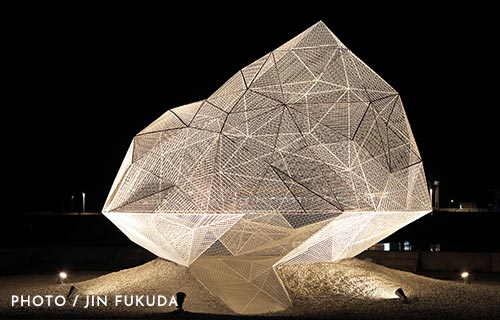
Naoshima
Kagawa-gun/Car & Ferry 1 hour 40 min.
Naoshima has gained worldwide acclaim in recent years as a haven for art lovers. Right from arrival in the port, visitors are greeted with sculptures like the Naoshima Pavilion and Yayoi Kusama's Red Pumpkin. The whole island is a museum, with immersive art installations, museums, and art pieces dotting the terrain.
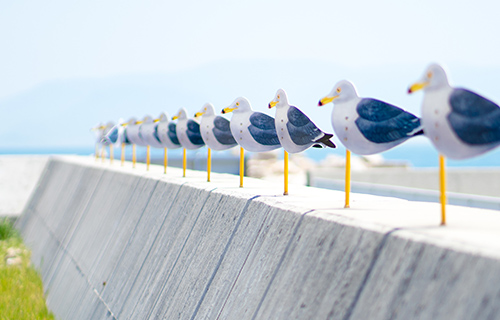
Megijima
Takamatsu City/Car & Ferry 1 hour 10 min.
From the ferry, visitors are greeted by Megijima's first major work, "The Seagull Parking Lot." With various art pieces blending into the landscape of the island, visitors can enjoy the harmony of nature and art. Japanese legend claims that ogres lived in a cave at the center of the island, so it is often referred to as "Onigashima", which is famous in Japan's folklore tradition.
Over 400 Years of History
